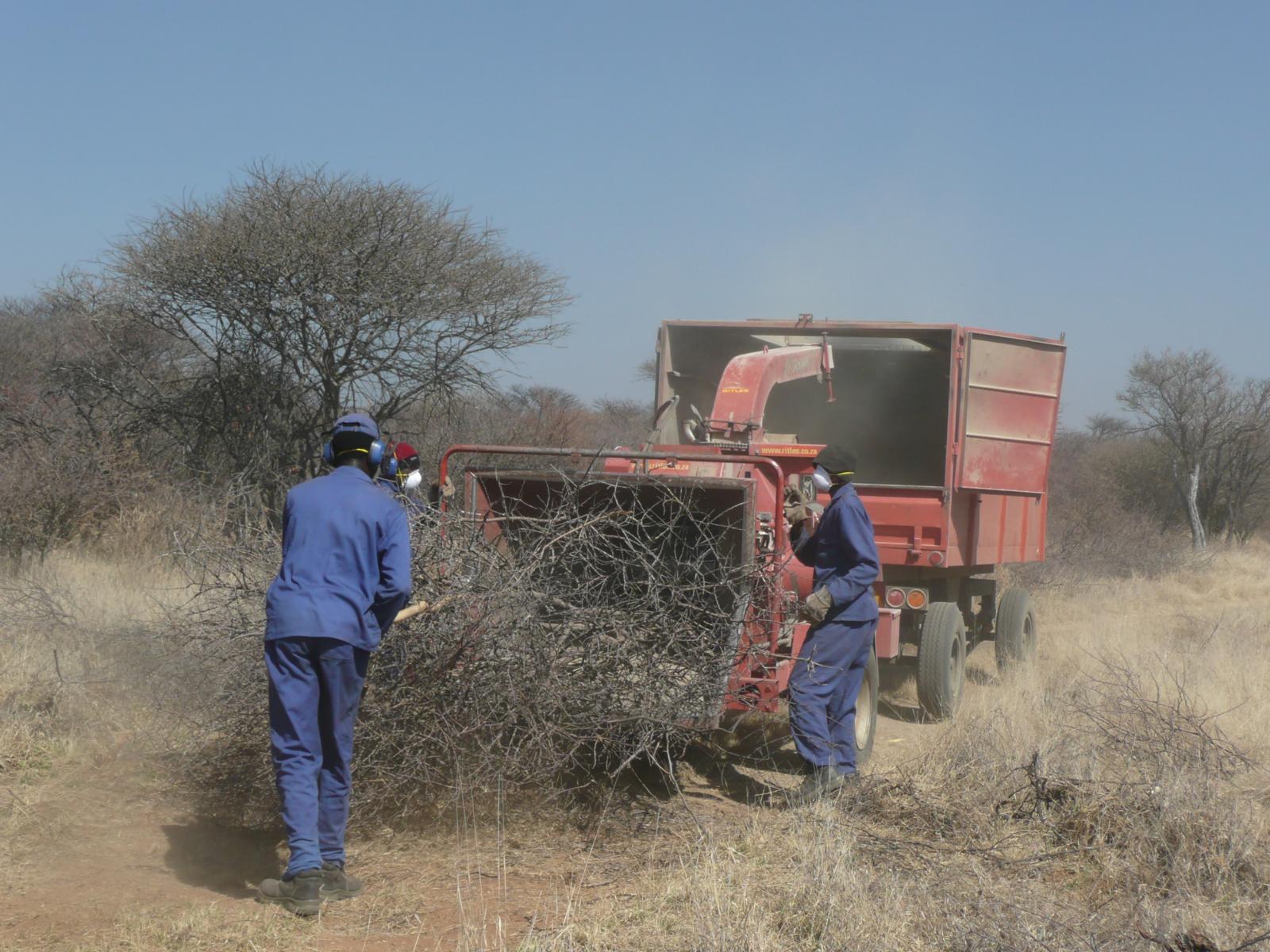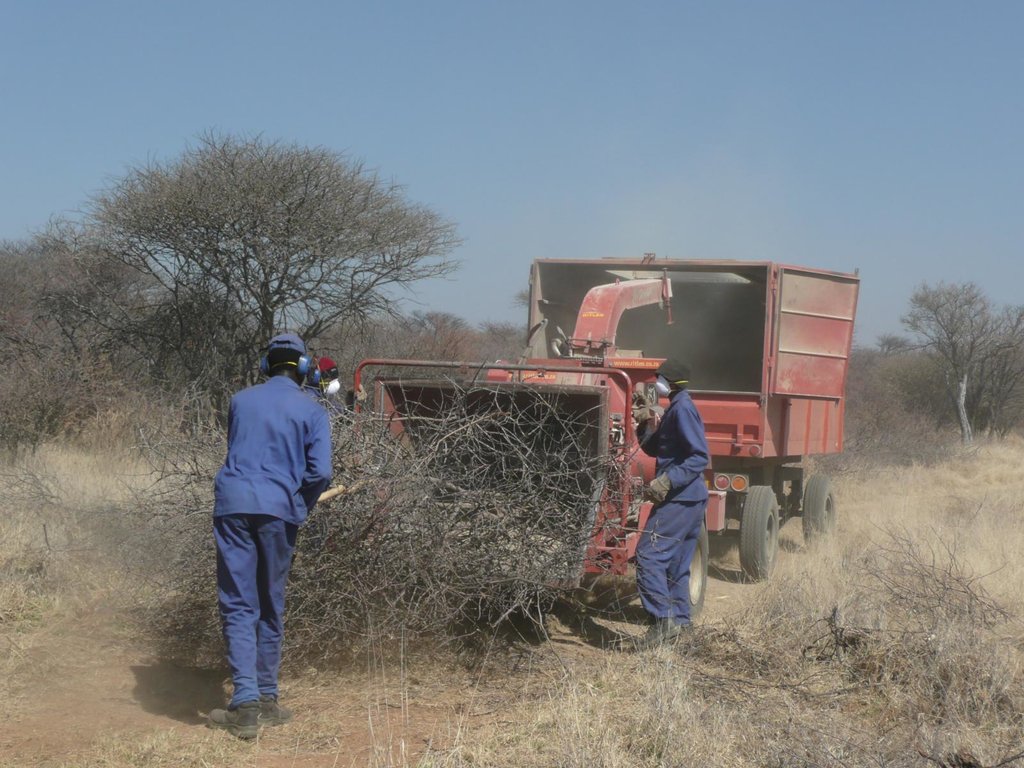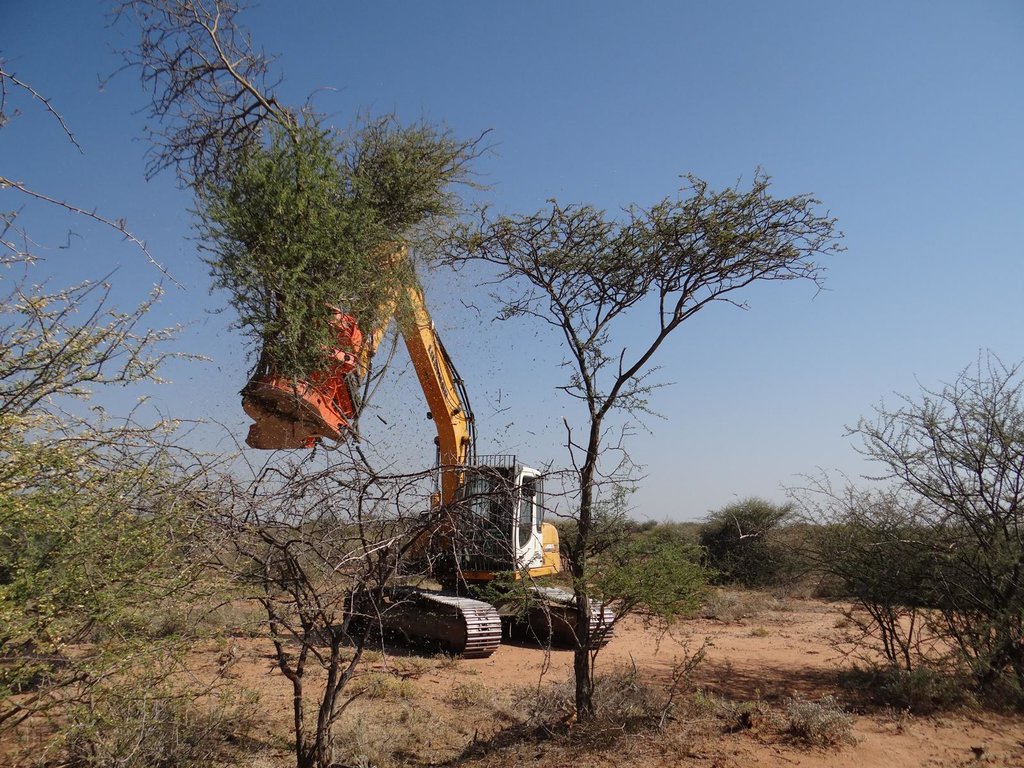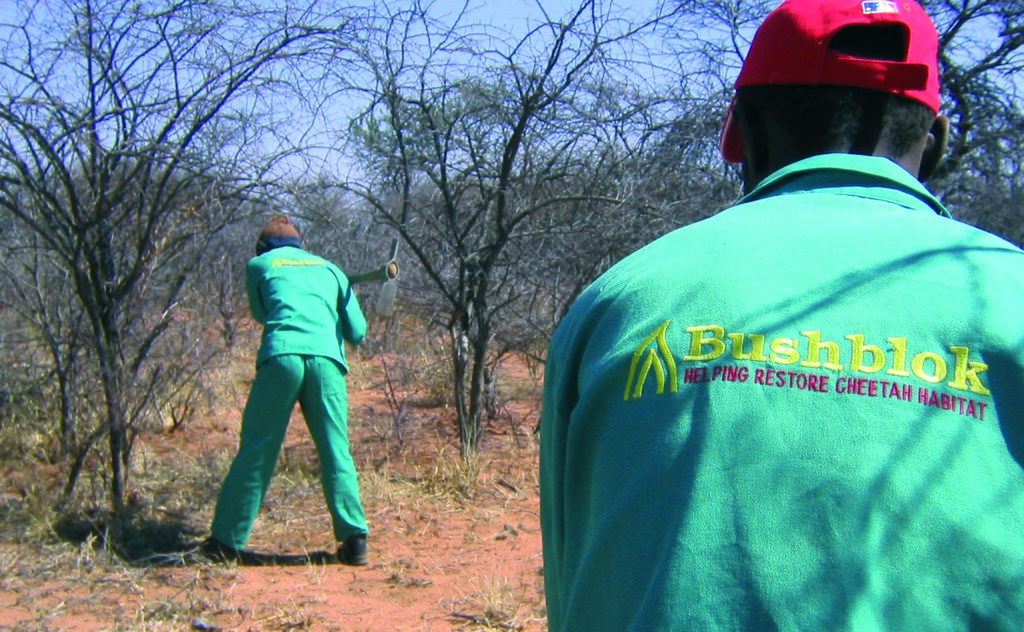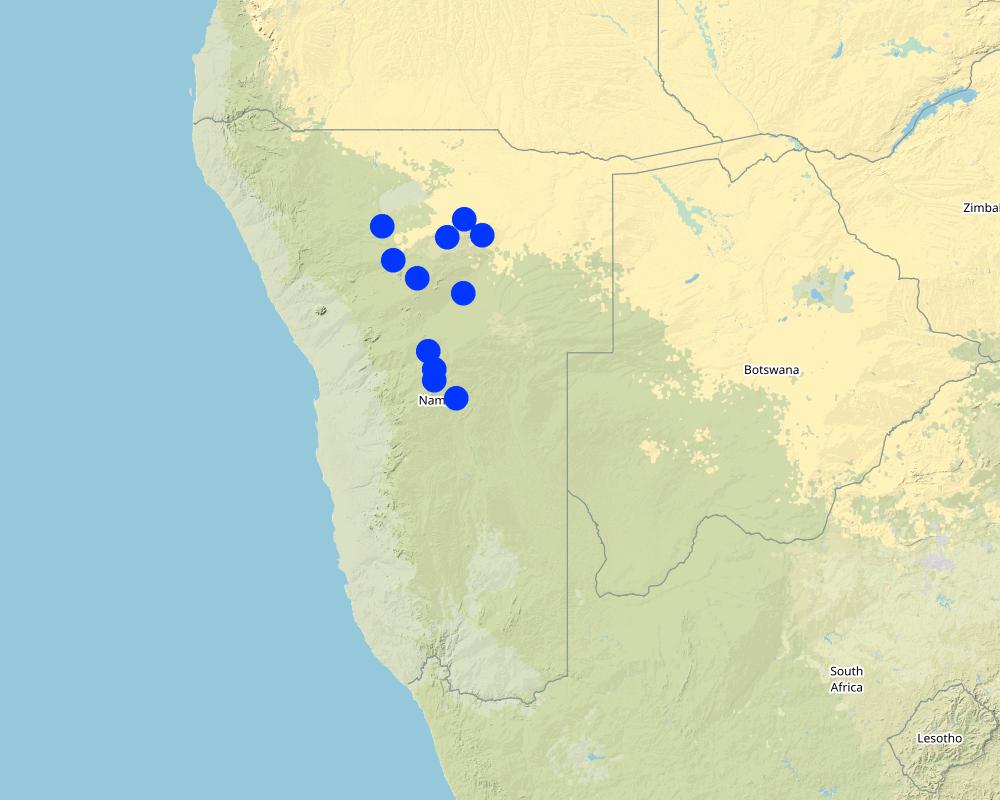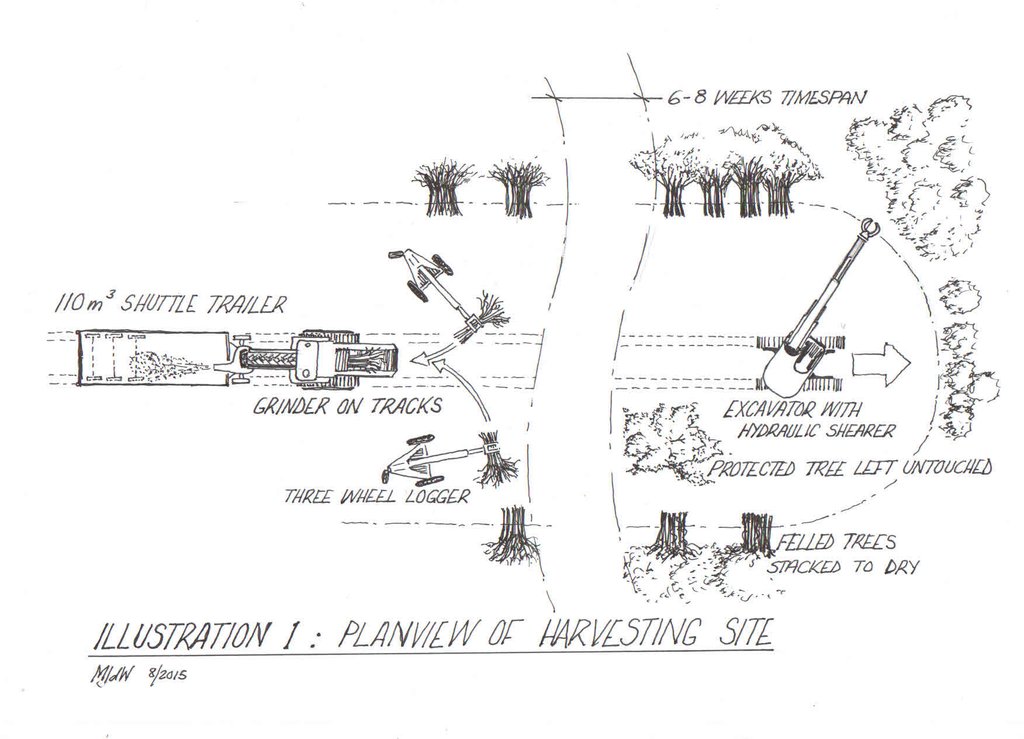Bush Thinning and Biomass Processing by Manual or Mechanised Means [纳米比亚]
- 创建:
- 更新:
- 编制者: Johannes Laufs
- 编辑者: Asellah David
- 审查者: Alexandra Gavilano, Rima Mekdaschi Studer, Simone Verzandvoort, Donia Mühlematter, Joana Eichenberger
Bush Thinning
technologies_2203 - 纳米比亚
- Bush Thinning and Biomass Processing by Manual or Mechanised Means: July 17, 2018 (inactive)
- Bush Thinning and Biomass Processing by Manual or Mechanised Means: May 31, 2019 (inactive)
- Bush Thinning and Biomass Processing by Manual or Mechanised Means: Nov. 2, 2021 (public)
- Bush Thinning and Biomass Processing by Manual or Mechanised Means: Feb. 21, 2018 (inactive)
- Bush Thinning and Biomass Processing by Manual or Mechanised Means: Aug. 22, 2017 (inactive)
查看章节
全部展开 全部收起1. 一般信息
1.2 参与该技术评估和文件编制的资源人员和机构的联系方式
SLM专业人员:
Gschwender Frank
有助于对技术进行记录/评估的项目名称(如相关)
GIZ Support to De-bushing Project有助于对技术进行记录/评估的项目名称(如相关)
Book project: Guidelines to Rangeland Management in Sub-Saharan Africa (Rangeland Management)有助于对技术进行记录/评估的机构名称(如相关)
Deutsche Gesellschaft für Internationale Zusammenarbeit (GIZ)1.3 关于使用通过WOCAT记录的数据的条件
编制者和关键资源人员接受有关使用通过WOCAT记录数据的条件。:
是
1.4 所述技术的可持续性声明
这里所描述的技术在土地退化方面是否存在问题,导致无法被认为是一种可持续的土地管理技术?:
否
注释:
The technology described is a means to rehabilitate degraded rangeland. Through targeted harvesting of bushes, the bush density is reduced, allowing for better growth of grass.
2. SLM技术的说明
2.1 技术简介
技术定义:
In Namibia, excess bush is harvested to reduce competition with other plants, especially grasses. Bush can be thinned manually (e.g. with axes), semi-mechanised (e.g. chainsaws) or fully mechanised (e.g. customised equipment). After cutting, the bush is left to dry and then processed into chips or other products.
2.2 技术的详细说明
说明:
Bush thinning is carried out in Namibia to restore degraded rangeland by stimulating the re-growth of grasses – which are suppressed by excess bush. About 30-45 million hectares are affected by bush encroachment, and this affects biodiversity, groundwater recharge and the carrying capacity of rangeland. There are many causes of bush encroachment, including overgrazing and reduced frequency of wildfires. Most bush encroachment involves indigenous, rather than invasive, species.
While natural transitions in the ecosystems may lead to reductions in bush encroachment, active rehabilitation measures are required for the short-term improvements. This is an absolute necessity for many farmers, who experience severe economic difficulties due to the reduced productivity of their rangeland.
Bush control comprises responsive measures (bush thinning), follow-up measures (aftercare) as well as preventative measures (good rangeland management). Since vast areas of Namibian rangeland are heavily encroached by bush, the focus is currently on bush thinning. This entails selective harvesting of bush. To determine the density of bush remaining after thinning, a formula based on tree equivalent (TE) and average annual rainfall is used. One TE is defined as a woody tree or bush of 1.5 metres in height.
As rule of thumb for attaining optimal bush density, about 30-35% of encroacher biomass should be removed. This is based on research carried out mainly in South Africa, measuring and comparing the re-growth after bush removal. Where too much bush was removed, this often resulted in even heavier encroachment.
Bush thinning follows strict environmental guidelines set by the Directorate of Forestry (DoF) through the Forestry Act and the Directorate of Environmental Affairs (DEA) through the Environmental Management Act. This governs the equipment used (to avoid soil disturbance) and the amount of bushes harvested (to achieve a healthy number of the desired bush species). The amount of bushes to be harvested is determined by an expert and depends on various factors.
While there is a lack of precise knowledge on the long-term effect of bush thinning, there is no doubt that control has an overall positive effect on the savannah ecosystem in Namibia. The need is widely recognised among land owners and acknowledged on the national political agenda.
To render bush thinning economically feasible, value chains have been developed. Through processing and utilisation of the woody biomass, income can be generated. Processed bush biomass can, for example in the form of chips, can be used for thermal and electrical energy applications (e.g. local biomass power plants or biomass boilers for industry). Currently two such energy installations exist in Namibia, one at a local brewery and one at a local cement factory. In addition, the national power utility NamPower currently considers the construction of a 20-40 MW biomass power plant.
Other existing value chains include the production of charcoal, firewood, poles, as well as bush -based animal feed. Further value chains under consideration include composite materials, such as wood-plastic, as well as biochar.
Scientific observations have shown, that bush thinning requires regular follow-up. These measures (“aftercare”) include the prevention of coppicing and re-growth. This can be achieved by applying aboricides selectively to the cut stems, stem fires or the introduction of browsers (e.g. goats). Research on the effectiveness and possible side effects of each of these methods is limited.
A major challenge is the limited suitability of available machines. The process leads to high wear and tear on the equipment (both harvesting and processing technology, (like chippers and pelletisers), often rendering operations unprofitable. Research into, and development of, more suitable machinery is necessary. Other requirements are improved skills training and continuous monitoring of the long-term effects on rangeland.
2.3 技术照片
关于照片的一般说明:
All photos have either been taken by the GIZ Support to De-bushing Project or were provided to the project by third parties.
2.4 技术视频
注释、简短说明:
https://www.youtube.com/watch?v=859GshR9hso&t=3s
Bush Encroachment in Namibia: Causes and Extent
An explanation of the root causes of bush encroachment and its impact on land in Namibia.
日期:
01/11/2015
位置:
Namibia
摄影师的名字:
GIZ Support to De-bushing Project
注释、简短说明:
https://www.youtube.com/watch?v=bmlzPDiqlxo&t=45s
Biomass Value Addition: Bush Based Products
An overview of existing and potential value chains based on encroacher bush.
日期:
01/11/2015
位置:
Namibia
摄影师的名字:
GIZ Support to De-bushing Project
注释、简短说明:
https://www.youtube.com/watch?v=MMSOfV2KBjA
Biomass Energy: From Bush to Electricity
Overview of the energetic applications of woody biomass from encroacher bush.
日期:
01/11/2015
位置:
Namibia
摄影师的名字:
GIZ Support to De-bushing Project
2.5 已应用该技术的、本评估所涵盖的国家/地区/地点
国家:
纳米比亚
有关地点的进一步说明:
Bush control is applied across Namibia on many privately owned farms. Activities are most concentrated in the regions Khomas, Omaheke, Otjozondjupa and Oshikoto.
具体说明该技术的分布:
- 均匀地分布在一个区域
如果技术均匀分布在一个区域,则指定覆盖的区域(单位为平方千米):
1200.0
如果不知道精确的区域,请注明大致覆盖的区域:
- 1,000-10,000 平方千米
注释:
Pointers on the map only indicate points (e.g. urban centres) around which activities are concentrated. It is not possible to depict each site where bush control is implemented due to the high number of individual activities and projects.
Currently bush thinning is implemented on a total of approximately 120.000 hectares (1.200 km2) of farmland per annum. These activities are not confied to certain areas, but spread across all of Namibia, typically concentrating in the most encroached areas (e.g. Otjozondjupa, Khomas, Oshikoto and Omaheke regions).
Map
×2.6 实施日期
注明实施年份:
2015
2.7 技术介绍
详细说明该技术是如何引入的:
- 通过土地使用者的创新
- 在实验/研究期间
- 通过项目/外部干预
注释(项目类型等):
Since the 1950s the phenomenon of bush encroachment has been recognised by farmers in Namibia and counter measures have been implemented over the decades. The technologies applied largely relied on the means and innovative capabilities of the respective land owner. Only as of 2014, through the introduciton of a national Support to De-bushing Project, are technologies systematically researched and tested in the field.
3. SLM技术的分类
3.1 该技术的主要目的
- 改良生产
- 减少、预防、恢复土地退化
- 保护生态系统
- 保持/提高生物多样性
- 创造有益的经济影响
3.2 应用该技术的当前土地利用类型

牧场
粗放式放牧:
- 经营牧场
动物类型:
- 山羊
- cattle
注释:
Main animal species and products: Cattle, goats, game
Namibia is characterised by large commercial cattle farms. Du to its aridity the land is largely unsuitable for crop farming, with exceptions in high-rainfall areas such as the Grootfontein, Tsumeb, Otavi triangle.
The Northern parts of Namibia are managed as communal land, where farmers have lease holds for their land. In these areas a combination of millet production and cattle herding is common.
Number of growing seasons per year: 1
Livestock density: 284 000 in targeted area (105460km2) of bush thinning (Otjozondjupa region).
3.3 由于技术的实施,土地使用是否发生了变化?
由于技术的实施,土地使用是否发生了变化?:
- 是(请在技术实施前填写以下有关土地利用的问题)
注释:
The implementation of bush thinning allows to maintain the land use (e.g. cattle ranching) and is typically applied to increase productivity in the long-term.
3.4 供水
该技术所应用土地的供水:
- 雨养
3.5 该技术所属的SLM组
- 畜牧业和牧场管理
- 改良的地面/植被覆盖
3.6 包含该技术的可持续土地管理措施

植物措施
- V4:更换或清除外来/入侵物种

管理措施
- M2:改变管理/强度级别
- M5:物种组成的控制/变化
3.7 该技术强调的主要土地退化类型

生物性退化
- Bh:栖息地丧失
- Bq:数量/生物量减少
- Bs:质量和物种组成/多样性的下降
3.8 防止、减少或恢复土地退化
具体数量名该技术与土地退化有关的目标:
- 防止土地退化
- 修复/恢复严重退化的土地
4. 技术规范、实施活动、投入和成本
4.1 该技术的技术图纸
技术规范(与技术图纸相关):
Drawing of a bush harvesting site layout. The drawing depicts fully mechanised bush harvesting and immediate processing into wood chips. This set-up is most suitable for large-scale bush thinning, e.g. for the purpose of supplying biomass in larger quantities. Such off-take includes the potential export of bush in processed form (pellets) or energetic utilisation (e.g. local biomass power plants or biomass boilers in the industry). Currently two such energy solutions exist in Namibia, one at a local brewery and one at a local cement factory.
Note that a range of bush harvesting methods exist, ranging from fully mechanised (as depicted) to manual bush harvesting (e.g. with axes). The site layout and principles are the same in all scenarios, but harvesting speed and costs differ.
The bush harvesting process:
Bushes are harvested selectively with and excavator, to which a hydraulic sheer cutter is attached. The biomass is stacked in rows and left for drying some six to eight weeks (depending on weather conditions). The biomass is then further processed with a chipper and collected with a trailer for further transport off the farm (e.g. to a biomass power plant or industrial off-taker). As a rule of thumb, one third of the standing biomass is removed, leaving two thirds standing. Harvesting starts with smaller plants and then moves to larger ones, cutting only plants with 15 centimetres of diameter or less (as per Namibian forestry regulations).
作者:
M.J. de Wet Pr. Eng., NRGen Advisors (Pty) LTD
日期:
18/09/2015
4.2 有关投入和成本计算的一般信息
具体说明成本和投入是如何计算的:
- 每个技术区域
注明尺寸和面积单位:
1 hectare
其它/国家货币(具体说明):
Namibia Dollar (NAD)
如相关,注明美元与当地货币的汇率(例如1美元=79.9巴西雷亚尔):1美元=:
0.078
注明雇用劳工的每日平均工资成本:
Namibia Dollar (NAD) 110
4.3 技术建立活动
| 活动 | 时间(季度) | |
|---|---|---|
| 1. | Bush harvesting/felling | Year around |
| 2. | Stacking (and drying) | Year around |
| 3. | Feeding the chipping operation | Year around |
| 4. | Transport | Year around |
注释:
The restorative measure includes bush harvesting/felling as well as aftercare measures. Additional activities include the processing (e.g. into chips) and transport of the woody material off the farm/land.
4.4 技术建立所需要的费用和投入
| 对投入进行具体说明 | 单位 | 数量 | 单位成本 | 每项投入的总成本 | 土地使用者承担的成本% | |
|---|---|---|---|---|---|---|
| 劳动力 | 1 x Mechanic | person days | 0.2 | 2000.0 | 400.0 | |
| 劳动力 | 4 x Operators | person days | 0.8 | 300.0 | 240.0 | |
| 劳动力 | 1 x Operation manager chipping | person days | 0.2 | 1000.0 | 200.0 | |
| 劳动力 | 1 x Chipping operator | person days | 2.0 | 150.0 | 300.0 | |
| 设备 | 1 x 12t Excavator | pieces | 1.0 | 120.0 | 120.0 | |
| 设备 | 2 x Hydraulic grab and shearing attachments | pieces | 2.0 | 60.0 | 120.0 | |
| 设备 | 2 x Three wheel loggers | pieces | 2.0 | 180.0 | 360.0 | |
| 设备 | 1 x Chipper | pieces | 1.0 | 840.0 | 840.0 | |
| 其它 | Management and administration overhead | lump sum | 1.0 | 200.0 | 200.0 | |
| 其它 | 12.0 | |||||
| 技术建立所需总成本 | 2780.0 | |||||
| 技术建立总成本,美元 | 35641.03 | |||||
注释:
Cost of bush harvesting can be calculated per hectare (e.g. land owner's perspective) or per tonne (in fuel supply agreements with off-takers). All given costs are approximations, as costs vary widely depending on the local framework conditions on a given piece of land. Typically the costs to harvest and process bush on one hectare range from 2,000 NAD to 4,000 NAD.
4.5 维护/经常性活动
| 活动 | 时间/频率 | |
|---|---|---|
| 1. | Aftercare | Annually |
注释:
When land is thinned it creates a vacuum in which weeds and woody plants (sometimes more aggressive colonisers than the original encroacher species) will quickly establish themselves. Regular aftercare needs to be applied in order to prevent the excessive re-growth of bush (and therewith new degradation of the land). Various methods are in use to manage the re-growth of bush following harvesting. These include selective application of arboricides, stem burning, and intensive browsing by goats or antelopes.
The more sustainable the bush harvesting itself has taken place, importantly not completely clearing larger areas of vegetation, the less likely is agressive re-growth of bush. In all bush thinning exercises it is important to leave larger bushes and trees untouched and to start by removing the smaller, less established bushes. In addition, not only individual larger bushes must be left standing, but also islands/patches of bushes, which fulfill important ecosystem services, e.g. habitat for animals.
4.6 维护/经常性活动所需要的费用和投入(每年)
如果您无法分解上表中的成本,请估算维护该技术所需要的总成本。:
500.0
注释:
Commonly aftercare is applied in form of manual application of herbicides to the cut stems, in order to prevent re-growth of the bushes.
4.7 影响成本的最重要因素
描述影响成本的最决定性因素:
(1) Investment in machinery (if not applied manually).
(2) Maintenance of machinery (high wear and tear due to hardness of wood and high mineral content).
(3) Remoteness of farms/land from buyers/markets.
5. 自然和人文环境
5.1 气候
年降雨量
- < 250毫米
- 251-500毫米
- 501-750毫米
- 751-1,000毫米
- 1,001-1,500毫米
- 1,501-2,000毫米
- 2,001-3,000毫米
- 3,001-4,000毫米
- > 4,000毫米
指定年平均降雨量(若已知),单位为mm:
350.00
有关降雨的规范/注释:
Namibia is a semi-arid country and rainfall ranges roughly from 150-550 mm per year (rough approximation due to the vastness of the area described).
注明所考虑的参考气象站名称:
Various
农业气候带
- 半干旱
5.2 地形
平均坡度:
- 水平(0-2%)
- 缓降(3-5%)
- 平缓(6-10%)
- 滚坡(11-15%)
- 崎岖(16-30%)
- 陡峭(31-60%)
- 非常陡峭(>60%)
地形:
- 高原/平原
- 山脊
- 山坡
- 山地斜坡
- 麓坡
- 谷底
垂直分布带:
- 0-100 m a.s.l.
- 101-500 m a.s.l.
- 501-1,000 m a.s.l.
- 1,001-1,500 m a.s.l.
- 1,501-2,000 m a.s.l.
- 2,001-2,500 m a.s.l.
- 2,501-3,000 m a.s.l.
- 3,001-4,000 m a.s.l.
- > 4,000 m a.s.l.
说明该技术是否专门应用于:
- 不相关
5.3 土壤
平均土层深度:
- 非常浅(0-20厘米)
- 浅(21-50厘米)
- 中等深度(51-80厘米)
- 深(81-120厘米)
- 非常深(> 120厘米)
土壤质地(表土):
- 粗粒/轻(砂质)
土壤质地(地表以下> 20厘米):
- 粗粒/轻(砂质)
表土有机质:
- 低(<1%)
5.4 水资源可用性和质量
地下水位表:
5-50米
地表水的可用性:
匮乏/没有
水质(未处理):
良好饮用水
水的盐度有问题吗?:
否
该区域正在发生洪水吗?:
否
5.5 生物多样性
物种多样性:
- 低
栖息地多样性:
- 中等
5.6 应用该技术的土地使用者的特征
定栖或游牧:
- 定栖的
生产系统的市场定位:
- 商业/市场
非农收入:
- 低于全部收入的10%
相对财富水平:
- 平均水平
个人或集体:
- 个人/家庭
机械化水平:
- 机械化/电动
性别:
- 女人
- 男人
土地使用者的年龄:
- 中年人
5.7 应用该技术的土地使用者使用的平均土地面积
- < 0.5 公顷
- 0.5-1 公顷
- 1-2 公顷
- 2-5公顷
- 5-15公顷
- 15-50公顷
- 50-100公顷
- 100-500公顷
- 500-1,000公顷
- 1,000-10,000公顷
- > 10,000公顷
这被认为是小规模、中规模还是大规模的(参照当地实际情况)?:
- 大规模的
注释:
Typical commercial farm size is 5.000 ha. The size increases with decreasing rainfall (towards southern Namibia).
5.8 土地所有权、土地使用权和水使用权
土地所有权:
- 个人,有命名
土地使用权:
- 个人
用水权:
- 个人
5.9 进入服务和基础设施的通道
健康:
- 贫瘠
- 适度的
- 好
教育:
- 贫瘠
- 适度的
- 好
技术援助:
- 贫瘠
- 适度的
- 好
就业(例如非农):
- 贫瘠
- 适度的
- 好
市场:
- 贫瘠
- 适度的
- 好
能源:
- 贫瘠
- 适度的
- 好
道路和交通:
- 贫瘠
- 适度的
- 好
饮用水和卫生设施:
- 贫瘠
- 适度的
- 好
金融服务:
- 贫瘠
- 适度的
- 好
6. 影响和结论性说明
6.1 该技术的现场影响
社会经济效应
生产
饲料生产
注释/具体说明:
Bush-based animal feed production has been successfully trialed and is implemented by various farmers across Namibia.
畜牧生产
注释/具体说明:
Carrying capacity of bush controlled land increases if regular aftercare is implemented.
能源生产
注释/具体说明:
Bush-to-electricity value chain under development. Several industrial off-takers use woody biomass for boilers (heat), the national power utility currently develops a first biomass power plant.
水资源可用性和质量
家畜用水的可用性
注释/具体说明:
Studies show a direct positive correlation between the extent of bush control and the availability of groundwater.
收入和成本
农业收入
注释/具体说明:
Bush based value addition, e.g. charcoal production, leads to additional income for land owners and farm workers.
收入来源的多样性
注释/具体说明:
Bush based value addition, e.g. charcoal production, leads to additional income for land owners and farm workers.
生态影响
生物多样性:植被、动物
生物量/地上C
植物多样性
外来入侵物种
注释/具体说明:
Alien species are completely removed where possible (e.g. Prosopis).
6.3 技术对渐变气候以及与气候相关的极端情况/灾害的暴露和敏感性(土地使用者认为的极端情况/灾害)
渐变气候
渐变气候
| 季节 | 增加或减少 | 该技术是如何应对的? | |
|---|---|---|---|
| 年降雨量 | 减少 | 不好 |
气候有关的极端情况(灾害)
气候灾害
| 该技术是如何应对的? | |
|---|---|
| 干旱 | 非常不好 |
注释:
Despite only limited research exists, long periods of drought that the country has recently faced, are credited to climate change. Drought intensifies the challenge for farmers, as already degraded rangeland has limited capacity to recover in the absence of rain. The technology of bush thinning itself has limited effect if no rain follows the removal of bushes.
6.4 成本效益分析
技术收益与技术建立成本相比如何(从土地使用者的角度看)?
短期回报:
消极
长期回报:
非常积极
技术收益与技术维护成本/经常性成本相比如何(从土地使用者的角度看)?
短期回报:
消极
长期回报:
非常积极
注释:
Bush thinned land takes 3-5 years to fully recover its productive grass layer, thus direct economic benefits are only experienced with a delay.
6.5 技术采用
- 单例/实验
如若可行,进行量化(住户数量和/或覆盖面积):
120'000 hectares are bush thinned per year in Namibia; figures on the increase
在所有采用这项技术的人当中,有多少人是自发的,即未获得任何物质奖励/付款?:
- 51-90%
注释:
Farmers largely implement bush control on their own initiative; increasingly value chains are being developed and dedicated service providers offer bush control.
6.6 适应
最近是否对该技术进行了修改以适应不断变化的条件?:
是
若是,说明它适应了哪些变化的条件:
- 不断变化的市场
具体说明技术的适应性(设计、材料/品种等):
Increasingly bush harvesting is carried out with mechanised means, aiming at large scale production for large biomass off-takers, both in the country and internationally.
6.7 该技术的优点/长处/机会
| 土地使用者眼中的长处/优势/机会 |
|---|
| Effective measure against bush encroachment |
| Costs can be balanced with additional income through the sale of the biomass/biomass based products |
| 编制者或其他关键资源人员认为的长处/优势/机会 |
|---|
| Apart from the main purpose of rehabilitating rangeland, bush control has various side benefits, such as employment creation and industrialisation. |
| Bush control and biomass utilisation can contribute to energy security in the country. |
| The available range of technologies (from manual to fully mechanised) allows to develop viable concept for all types of land/land ownership scenarios. |
6.8 技术的弱点/缺点/风险及其克服方法
| 土地使用者认为的弱点/缺点/风险 | 如何克服它们? |
|---|---|
| High initial costs involved. | Development of dedicated financial products. |
| Possible negative consequences, such as more aggressive re-growth of species. | Increased knowledge dissemination, skills development and mentorship programmes. |
| 编制者或其他关键资源人员认为的弱点/缺点/风险 | 如何克服它们? |
|---|---|
| Necessity of cross-sector collaboration, e.g. agriculture, forestry, environment, industry, energy and resulting complexity. | Introduction of effective steering body on national level. |
| Challenges to sustain operations in communal areas/on land that is not owned by individuals. | Development of concepts for community based projects and cooperation with relevant regional authorities and decision making bodies (e.g. Regional Councils, Conservancies). |
7. 参考和链接
7.1 信息的方法/来源
- 实地考察、实地调查
De-bushing Advisory Service Demand Survey (2015), 361 respondents
- 根据报告和其他现有文档进行编译
Various
(现场)数据是什么时候汇编的?:
01/08/2014
7.2 参考可用出版物
标题、作者、年份、ISBN:
Baseline Assessment for De-bushing Programme in Namibia (2014)
可以从哪里获得?成本如何?
GIZ Support to De-bushing Project, www.dasnamibia.org/downloads
标题、作者、年份、ISBN:
Demand Survey for the implementation of a De-bushing Advisory Service (2015)
可以从哪里获得?成本如何?
GIZ Support to De-bushing Project, www.dasnamibia.org/downloads
标题、作者、年份、ISBN:
Value Added user-opportunities for encroacher bush (2015)
可以从哪里获得?成本如何?
GIZ Support to De-bushing Project, www.dasnamibia.org/downloads
标题、作者、年份、ISBN:
Compendium of harvesting technologies for encroacher bush (2015)
可以从哪里获得?成本如何?
GIZ Support to De-bushing Project, www.dasnamibia.org/downloads
标题、作者、年份、ISBN:
Assessment of biomass resource and potential yield in Namibia (2015)
可以从哪里获得?成本如何?
GIZ Support to De-bushing Project, www.dasnamibia.org/downloads
标题、作者、年份、ISBN:
Strategic Environmental Assessment (SEA) on bush thinning and biomass utilisation (2015)
可以从哪里获得?成本如何?
GIZ Support to De-bushing Project, www.dasnamibia.org/downloads
标题、作者、年份、ISBN:
Assesment of financial products and incentive schemes for bush harvesting and value addition (2015)
可以从哪里获得?成本如何?
GIZ Support to De-bushing Project, www.dasnamibia.org/downloads
标题、作者、年份、ISBN:
Environmental and forestry bush harvesting guidelines and generic Environmental Management Plan (2016)
可以从哪里获得?成本如何?
GIZ Support to De-bushing Project, www.dasnamibia.org/downloads
标题、作者、年份、ISBN:
Regional assessment of the economics of land degradation related to bush encroachment in Otjozondjupa, Namibia
可以从哪里获得?成本如何?
GIZ Support to De-bushing Project, www.dasnamibia.org/downloads
7.3 链接到网络上的相关信息
标题/说明:
De-bushing Advisory Service (DAS) Namibia, Resource Section
URL:
www.dasnamibia.org/downloads
标题/说明:
Namibia Biomass Industry Group (N-BiG)
URL:
www.n-big.org
标题/说明:
Videos
URL:
https://www.youtube.com/channel/UCwCICCfwf0SdVBqg2ZcAcKA
标题/说明:
Namibia Charcoal Association (NCA)
URL:
www.ncanamibia.com
链接和模块
全部展开 全部收起链接
无链接
模块
无模块


